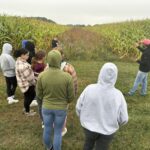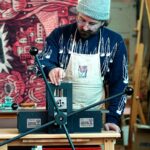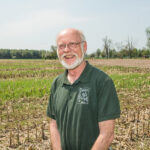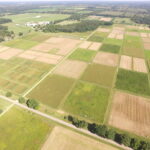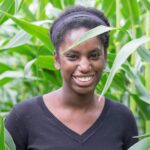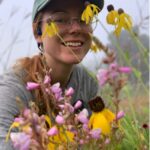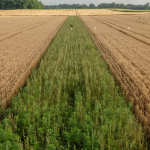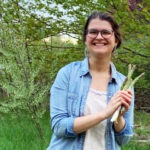Throughout 2022 and 2023, Melissa Frost, biology and chemistry teacher at Buchanan High School, joined the KBS LTER through our Research Experience for Teacher (RET) program. The NSF-funded RET program partners teachers with scientists to assist in ongoing research in the lab, as well as providing the teacher the opportunity to develop their own research project. Melissa joined Sarah Evan's lab, and worked with scientists Jennifer Jones and Caitlin Broderick. Melissa embraced the RET as a chance to integrate more research and data into her teaching. "Participating in a RET program allowed
2023 KBS LTER Artist-in-Residence set for June 12-18
A Kalamazoo woodcut printmaker and teacher is the 2023 Artist-in-Residence for Michigan State University’s W.K. Kellogg Biological Station in Hickory Corners, Michigan. Launched by MSU in Summer 2022 in an effort to promote art and science collaborations, the Farmscapes to Forests: Kellogg Biological Station (KBS) Long-Term Ecological Research (LTER) Artist-in-Residence Program is now in its second year and will host Trevor Grabill from Flat Mountain Press June 12-18 as the 2023 Artist-in-Residence. According to Gretel Van Wieren, Professor of Religious
Long-time collaborator with KBS, Dean Baas, recognized as NRC-SARE Hero
Dean Baas: NCR-SARE Hero Coordinated by the NCR-SARE Alumni Organization, the term “NCR-SARE Hero” recognizes the leadership, vision, contributions, and impact that individuals have made in the field of sustainable agriculture in the region. Dean Baas’ academic training started at Michigan State University (MSU), where he received a bachelor’s degree in agricultural engineering. Baas worked for 20 years with the Kellogg Company in Battle Creek, Michigan, in technical/management positions, before returning to MSU to undertake a doctorate in environmental geosciences and biosystems
KBS Long-Term Ecological Research program awarded $7.65 million NSF grant
The W.K. Kellogg Biological Station Long-Term Ecological Research program at Michigan State University recently received a renewal of its foundational grant from the National Science Foundation, reaffirming its future and status as one of the country’s premier research sites. Established in 1989, the KBS LTER is one of 28 NSF LTER sites nationally and is the only one dedicated to understanding the ecology of agricultural systems. With a focus on row crops, the 34-year-old program studies how agriculture can be environmentally friendly without harming yields. A renewal
Article featuring KBS research wins outstanding paper award
A paper that examines best practices for improving soil health over time has been recognized as outstanding by the American Society of Agronomy, or ASA. The paper, spearheaded by W.K. Kellogg Biological Station resident faculty and MSU assistant professor Christine Sprunger, detailed research that was conducted at the KBS Great Lakes Bioenergy Research Center site. Tvisha Martin and Meredith Mann also contributed to the paper, titled “Systems with greater perenniality and crop diversity enhance soil biological health,” which was originally published in 2020 in the journal Agricultural
The ABC’s – Agriculture, Beneficial Beetles and Conservation: Reflections from an LTER Fellow
Cynthia Fiser is a graduate student in Doug Landis's lab in the Michigan State University Department of Entomology. Her research looks at the impact of perennial prairie strips on the dispersal of ground beetles in row crop agriculture. Rolling hills of wheat, corn and soybean are a beautiful and nostalgic feature of the summer landscape in the Midwest. Here, agriculture is as much a part of the culture as the economy – anyone who attends a county fair would agree! However, the pressure placed on our agricultural landscapes to meet global demands for food, fuel and fiber takes a toll on
Little strips of prairie can go a long way
New research out of MSU shows that it is possible to manage farmland to address two challenges simultaneously – protecting biodiversity and maintaining ecosystem services. The key is to strategically place native perennial vegetation within agricultural systems, using the innovative practice of prairie strips. Today, 38% of the landscape in the Midwest is planted in row crop agriculture. “We need to make this land habitable for species for the ecosystem services the increased biodiversity can provide to the farms” said Lindsey Kemmerling, the first author of the MSU-led study
Transforming Michigan’s agricultural landscapes – Do prairie strips diversify insect communities in squash production?: Reflections from an LTER Fellow
Jen Zavalnitskaya is a graduate student in Zsofia Szendrei's lab in Michigan State University's Department of Entomology. Her research interests include plant-insect interactions, insect behavior, integrated pest management, and agroecology By the time I began my PhD, I knew I was passionate about promoting the biodiversity of agricultural landscapes. From my masters research in Zsofia Szendrei’s lab, I learned that the ways farmers manage their fields plays an important part in insect pest dynamics. However, the local landscape plays a large role as well. This creates a challenge,
New KBS LTER Artist-in-Residence program aims to create intersection between art and research
This spring, Michigan State University launches the Farmscapes to Forests: Kellogg Biological Station (KBS) Long-Term Ecological Research (LTER) Artist-in-Residence Program, which will welcome artists from across all mediums to spend a week at the Kellogg Biological Station in Hickory Corners, Michigan, followed by a culminating visit in the fall or winter to share their work. Supported by the National Science Foundation, Gretel Van Wieren, Professor in MSU’s Department of Religious Studies, is leading the program in its first collaboration with Dream Scene Placemaking,
Species interactions in prairie strips: Reflections from an LTER Fellow
Graduate researcher, Alice Puchalsky, is a Ph.D. student in Dr. Nick Haddad's lab at Michigan State University. Her research focus is on moths, butterflies, and interaction networks. When I began graduate school, I did not imagine myself eagerly watching a caterpillar writhe around in a plastic cup, wondering about its fate. But, that is where I found myself this past summer. I also did not imagine the delight I would feel in checking on that caterpillar the next day and finding that approximately 30 very small parasitic flies had emerged from that caterpillar’s body. I was hoping that
